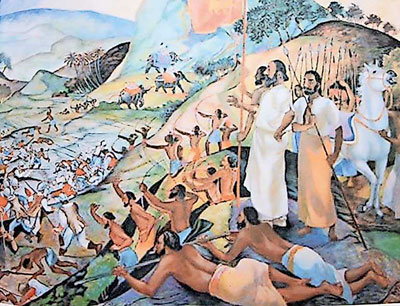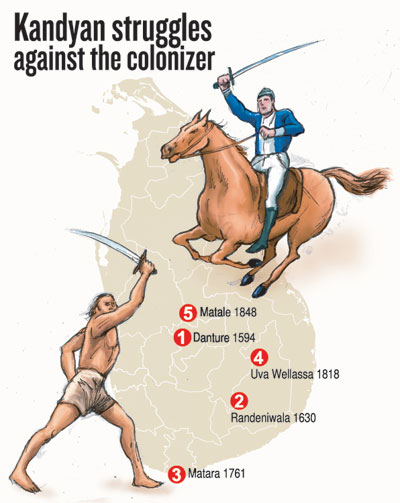75th Independence
Battles leading to Independence
View(s):- A journey through Lanka’s history of rebellion against foreign rule
By Yomal Senerath-Yapa
Freedom struggles have marked the vellum of Lanka’s history with gory scarlet stains from the Anuradhapura period — mostly to overthrow the foreign princes from South India laying waste on the land.

Artist Stanley Kirinde's Battle of Danture, the model for the painting at the Makola Army Staff College.
K. M. P. Kulasekera, Emeritus Professor of History at the Kelaniya University, says ours is what historians today call “a traditional resistance” to foreigners.
The Portuguese were fated to be routed with their ‘worst defeat ever’ in 1559 by Tikiri Bandara, then 28 years; the ‘Lion of Sitawaka’ who was to pose a threat to the Parangi till his death in 1593.
Danture (1594)
The Battle of Danture in 1594 was the first of the legendary Kandyan struggles to safeguard the hill capital. The indefatigable Pedro Lopes de Sousa of the Portuguese marched up with a former Kandyan king’s daughter, Dona Catarina, to be installed on the throne of Vimaladharmasurya (himself Portuguese-raised before turning rebel). They managed to seize the throne but the new queen and her advisers were unpopular and the former king used guerrilla tactics to such an effect that the Portuguese were destroyed and Vimaladharmasurya took the throne as well as the heiress-queen.
Randeniwela (1630)
King Senerath (who married the widowed Dona Catarina after Vimaladharmasurya) sent his warlike son Maha Asthana (to be crowned Rajasinha II) to battle the Portuguese at old Wellawaya on August 25, 1630.
Governor Constantinu De Sa de Noronha was made utterly helpless when the Lascarin (local soldiers) joined the Kandyan forces. A rain of arrows and bullets then besieged the men in the night and torrential rain ensured the gunpowder and matches of their arquebuses (long guns) did not work.
Dom Cosmo, the Lascarin captain, who began the revolt was given many nindagam and the Katugaha Walawwa whence sprang the old noble family of which Monerawilla Keppetipola was a scion.
Matara (1761)
The Dutch took over the maritime provinces in 1640. In 1761, the Matara rebellion saw the army of Kandy’s Kirti Sri Rajasinha bombarding the Matara Fort with cannonballs.
The Dutch spiked their own cannon and destroyed their ammunition and provisions, the garrison being evacuated by two ships that were waiting at sea. The Dutch recaptured the fort on February 2, 1762, finding eight cannons on the walls, including an English one.
Uva-Wellassa (1818)
Of the two ‘great rebellions’, the first in 1818 is characterised by being led by the Kandyan nobles, utterly disgruntled just three years after they signed the Kandyan Convention with the British.
The Governor was Robert Brownrigg. Many chiefs sent to suppress the first skirmishes joined the rebellion, including Keppetipola Disawe.
Major Sylvester Douglas Wilson, the Assistant Resident in Badulla was killed and the rebels soon gained much control over the region. A pretender to the throne of Kandy, Wilbawe was proclaimed king.
Governor Brownrigg established his field headquarters at Kandy and directed military operations against the rebels, who had resorted to hit-and-run attacks, with the assistance of Kandyan chiefs who remained loyal. Brownrigg soon received reinforcements from British India. Following the capture of rebel leaders, the rebellion fizzled out as the last remaining rebel holdouts were captured.
Matale (1848)
Matale was the rebellion of the ‘hoi polloi’ as opposed to 1818 which was of the nobles.
Due to the economic depression in the United Kingdom from July 1, 1848, licence fees were imposed on guns, dogs, carts, and shops while labour was made compulsory on plantation roads.
The taxes were a burden on the peasants.
On July 26, 1848, the ordinary people rose up, their leaders entering the Dambulla Temple where they consecrated Gongalegoda Banda as king — given the sonorous title “Sri Wickrama Subha Sarva Siddhi Rajasinghe”.
His brother was made yuva-raja and a certain Dingirirala the king of Sat-Korale. Veera Puran Appu became the sword bearer to Gongalegoda Banda and attended his consecration ceremony with 4,000 others.
After the anointing, the new king set forth to capture Kandy, attacking the Matale kachcheri and destroying tax records. Simultaneously, Dingirirala instigated attacks in Kurunegala, where eight people were killed by the British.
However, the rebellion ended with the capture of Veera Puran Appu and of Gongalegoda Banda and Dingirirala a few months later.

